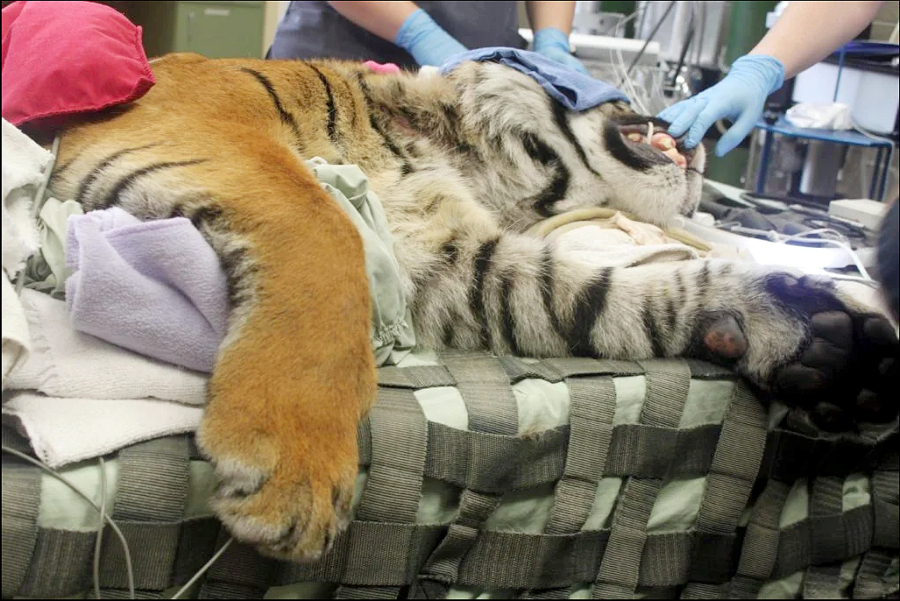Laughter echoed across Point Defiance Zoo one recent morning as children and families peered through panes of glass to catch glimpses of their favorite animals.
In a quiet building at the edge of the grounds, associate veterinarian Kadie Anderson and her crew gathered around an examination table Tuesday for an even more up-close-and-personal experience.
Their patient? A 10-year-old Sumatran tiger named Kali.
Kali is one of Point Defiance’s three Sumatran tigers, and this week she received her first wellness exam in three years. Routine exams like this one, which are funded by the zoo’s general operating budget, give the healthcare team a chance to perform extensive check-ups on their resident animals.
“Our keepers do a fantastic job of monitoring the health of those animals — and I’ll tell you, they pick up on the littlest things,” Anderson said. “But sometimes we don’t always know if there’s something wrong with them because they’re so good at hiding things, so this really just allows us to get a good in-hand evaluation.”
At Tuesday’s exam, a team sedated Kali before hooking her up to EKG leads to monitor her heart rate, blood pressure, temperature and breathing. Then they got to work performing X-rays and an ultrasound, clipping Kali’s nails and cleaning her teeth. According to Anderson’s observations, she’s a healthy tiger.
Preparing for a tiger wellness exam isn’t an easy process, Asian animal curator Telena Welsh said, but Kali’s cooperation has made a big difference.
Kali was born at Point Defiance in 2013. Because she was hand-raised by keepers like Welsh, she tends to be more comfortable being touched. She’s also plenty comfortable vocalizing her opinions — to humans and other tigers alike. Welsh recalls when Kali was younger she would call often down the hall if she felt like she wasn’t getting enough attention.
“She is one of those cats that really knows what she wants, and she knows what’s going on,” Welsh said. “She takes in all the details around her.”
When Kali was 6 months old, Welsh began training her to receive injections while awake, using positive reinforcement in the form of treats. Welsh gradually worked her way up, first helping Kali get comfortable being poked by a finger, and then switching to a blunted paper clip and later a real needle. Now, that training makes it easier for the healthcare team to sedate Kali when it needs to, like for routine wellness checks. Kali is also trained to let keepers do blood draws from her tail while awake, which helps them check her more frequently without the need for injections.
While the healthcare team’s work helps keep individual tigers like Kali healthy, it also fits into a bigger picture of conservation.
Sumatran tigers are one of the most endangered subspecies of tigers in the world, Welsh said, with fewer than 500 still alive in the wild. In the face of threats like poaching and deforestation, Point Defiance and other zoos’ involvement in the Species Survival Plan is one way to help ensure new generations of tigers.
“If we lose that wild population, we could lose this species forever, and so propagating them in captivity allows us to have kind of that reserve population, to make sure we don’t lose the species,” Anderson said.
The team’s work isn’t just about propagation, though.
Keeping tigers at Point Defiance healthy also allows the cats to connect with the public in a way they never could in the wild, Welsh said, which often encourages people to learn more about tiger conservation and to donate and change behaviors to support the cause.
“Sometimes it’s out of sight, out of mind,” Welsh said. “And so for us, the cats that we have here and all of the animals really are kind of ambassadors for those species in the wild and really help to drive that story.”
To Anderson, that up-close connection is invaluable.
“They’re amazing. They’re beautiful. They’re powerful,” she said. “Being able to see a tiger in person just really engages people in a way that nothing else can.”



